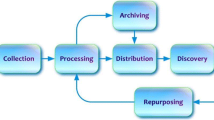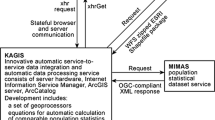Abstract
Field work is needed in many scientific disciplines as well as practice, e.g., surveying or environmental monitoring. Despite the goal of making the data collection process more effective, mobile geocomputing tools are a means to control data quality during data collection. Such tools must consider the conceptual data models of real world features that are developed in specific spatial information communities. Mobile GIS tools can support data quality through functions that control simultaneously the data entered by field workers. Semantic integrity of the database can be achieved through semantic plausibility controls, i.e., rules implemented in a knowledge base that help avoid the occurrence of inconsistencies. Such knowledge based functions must take into account the dependencies that exist between data quality and data semantics. Exemplarily, such dependencies are described in this paper as well as the knowledge based functions that are integrated as Dynamic Link Libraries into a mobile GIS. The examples demonstrate the strong application dependency of data quality and raise the question of how to integrate information about specific quality requirements into data models, e.g., for the purpose of multiple data use. The use of data modeling languages to achieve comprehensive data quality descriptions that consider adequately the dependencies between data quality and semantics is proposed and some hints on potentially useful linkages with other techniques to describe data and their semantics are given.
Similar content being viewed by others
References
ANZLIC. Core Metadata Elements for Land and Geographic Directories in Australia and New Zealand. http://www.anzlic.org.au/metaelem.htm, 1997.
R.B. Bailey. Ecosystem Geography. Springer, New York, Berlin, 1996.
K. Beard. “Representations of Data Quality,” in M. Craglia and H. Couclelis (Eds.,), Geographic Information Research—Bridging the Atlantic, Taylor & Francis, London, Philadelphia, 280-294, 1997.
L. Becker, L. Bemard, J. Döllner, S. Hammelbeck, K.H. Hinrichs, T. Krüger, B. Schmidt, and U. Streit. “Integration dynamischer Atmosphärenmodelle mit einem (3 + 1)-dimensionalen objektorientierten GIS-Kern (Integration of dynamic atmospheric models with a (3 + 1)-dimensional object oriented GIS Kernel),” Umweltinformatik 99, Metropolis Verlag, Marburg, Germany, 429-442, 1999.
S. Biörklund. “GPS in powerful combination with geographical databases and digital maps,” Proc. of the 18th Int. Cartographic Conference, Stockholm, Vol. 4:2117-2124, 1997.
Y. Bishr, H. Pundt, and Chr. Rüther. “Proceeding on the road of semantic interoperability—Design of a semantic mapper based on a case study from transportation,” Interoperating Geographic Information Systems, Lecture Notes in Computer Science 1580, 203-215, 1999.
Y. Bishr and W. Kuhn. The Role of Ontologies in Modelling Geospatial Features. IfGI prints 5, Institute for Geoinformatics, University of Münster, Wissenschaftsverlag, Solingen, 1999.
M. Breunig. Integration of Spatial Information for Geo-Information Systems. Springer, Lecture Notes in Earth Sciences 61, Heidelberg, New York, 1996.
D. Brickley. RDF Sitemaps and Dublin Core Site Summaries. http://rudolf.opensource.ac.uk/ about/specs/ sitemap.html, 2000.
J. Broekstra, M. Klein, S. Decker, D. Fensel, F. van Harmelen, and I. Horrocks. “Enabling knowledge representation on the Web by extending RDF Schema,” in Proceedings of the tenth World Wide Web conference WWW'10, 467-478, 2001.
CEN. Geographic Information—Data Description—Quality. Draft European Standard, PrEN 12656, European Committee for Standardization, Brussels, 1996.
E.F. Codd. “Data models in database management,” Proceedings Workshop on Data Abstraction and Conceptual Modeling. Cited after: D. Peuquet. “A Conceptual framework and comparison of spatial data models,” Introductory Readings in Geographic Information Systems, Taylor & Francis, London, New York, 230–245, 1991.
M. Duckham and J. Drummond. “Implementing an object-oriented approach to data quality,” in B. Gettings (Ed.), Integrating Information Infrastructures with GI Technology, Taylor & Francis, London, Philadelphia, 53-64, 1999.
S. Faiz, J.P. Nzali, and P. Boursier. “Representing the quality of geographic information depending on the User Context,” Proc. of the Joint Europ. Conf. on Geogr. Information, Barcelona, Vol. 1:73-76, 1996.
A. Frank. “Metamodels for data quality description,” in M.F. Goodchild and R. Jeansoulin (Eds.), Data Quality in Geographic Information: From Error to Uncertainty, Edition Hermes, Paris, 15-30, 1998.
M. Gahegan. “Characterizing the semantic content of geographic data, models, and systems,” in M. Goodchild, M. Egenhofer, R. Fegeas, and C. Kottmann (Eds.), Interoperating Geographic Information Systems, Kluwer Academics, 71-83, 1999.
K. Gardels. A Comprehensive Data Model for Distributed, Heterogeneous Geographic Information. http://www.regis.berkeley.edu/gardels/geomodel_def.html, 1996.
M.F. Goodchild, and S. Gopal. Accuracy of spatial databases. Taylor & Francis, London, 1989.
M.F. Goodchild. “Attribute accuracy,” Elements of Spatial Data Quality, S.C. Guptill and J.L. Morrison (Eds.), Elsevier Science Ltd., BPC Wheatons Ltd, Exeter, UK, 59-79, 1995.
M.F. Goodchild. “The spatial data infrastructure of environmental modeling,” GIS and Environmental Modeling: Progress and Research Issues, GIS World Books, Fort Collins, USA, 11-15, 1996.
F. Harvey. “Quality is Contextual,” in M.F. Goodchild and R. Jeansoulin (Eds.), Data Quality in Geographic Information: From Error to Uncertainty, Edition Hermes, Paris, 37-42, 1998.
F. Harvey, W. Kuhn, W.H. Pundt, Y. Bishr, and C. Riedemann. “Semantic interoperability: a central issue for sharing geographic information,” The Annals of Regional Science, Vol. 33(2), 1999, Springer-Verlag, Berlin, Heidelberg, 213-232, 1999.
C. Heisig. Mobile Erfassung raumbezogener Daten mit Pen-Computern und GPS (Mobile Acquisition of Spatial Data with Pen-Computers and GPS). http://www.conterra.de/service/presse/CH_HP983.htm, 1998.
ISO, http://www.statkart.no/isotc211/protdoc/211n919/211n919.doc, 2000.
P.C. Jackson. Introduction to Artificial Intelligence. Dover Science Books, Dover Publications, Inc. New York. 1985.
R. Jasper and M. Uschold. A Framework for Understanding and Classifying Application Ontologies. http://sern.ucalgary.ca/KSI/KAW/KAW99/papers/Uschold2/final-ont-apn-fmk.pdf, 1999.
W. Kuhn. “Defining semantics for spatial data transfers,” Proc. of the 6th Int. symp. on Spatial Data Handling, Edinburgh, Vol. 2:973-987, 1994.
W. Kuhn. An Algebraic Interpretation of Semantic Networks. Spatial Information Theory. Proc. of the Int. Conference COSIT '99, Lecture Notes in Computer Science, Springer, 331-347, 1999.
S.Y. Lam and Y.Q. Chen. “Ground-based positioning techniques,” in Y.Q. Chen and Y.C. Lee 2001, Geographical Data Acquisition, Springer, Wien, New York, 85-97, 2001.
D.M. Mark. Toward a Theoretical Framework for Geographic Entity Types. Spatial Information Theory, Lecture Notes in Computer Science 716, Springer, 270-283, 1993.
D. Martin. Geographic Information Systems, 2nd edition, Routledge, London, New York.
T.H. Merret, T.J. Otoo, A. Thiyagarajah, A. Valdivia-Martinez, and X.Y. Zhao. “Interoperation of heterogeneous GIS via database communication: a prototype,” Proc. 8th Int. Symp. on Spatial Data Handling, University Vancouver, Canada, 277-286, 1998.
D.R. Miller. Knowledge-Based Systems for Coupling GIS and Process-Based Ecological Models. GIS and Environmental Modeling: Progress and Research Issues. GIS World Books, Fort Collins, USA, 231-234, 1996.
H. Moellering. “Metadata: an essential component of the spatial data environment,” Proc. of the 18th International Cartographic Conference, Stockholm, Vol. 4:2076-2083, 1997.
J.M. Morrison. Spatial Data Quality. Elements of spatial data quality. Elsevier Science Ltd., BPC Wheatons Ltd., Exeter, UK, 1-12, 1995.
OGC. Open GIS Consortium. http://www.opengis.org/, 2000.
A. Östmann. “Quality systems for spatial data,” Proc. of Joint European Conference and Exhibition on Geographical Information, Barcelona, March 27–29, 1996. Proceedings Vol. 1, IOS press Amsterdam, Tokyo, 268-276, 1996.
A. Östmann. “The specification and evaluation of spatial data quality,” Proc. of the 18th International Cartographic Conference, Stockholm, Vol. 4:836-847, 1997.
H. Pundt, A. Hitchcock, M. Bluhm, and U. Streit. “A GIS supported freshwater information system including a Pen-Computer component for digital field data recording,” Proceedings of the International Conference on GIS for Hydrology and Water Resources Management, IAHS Publication No. 235, 703-711, 1996.
H. Pundt. Wissensbasierte Komponenten zur Verbesserung der Datenqualität bei digitalen Feldkartierungen (Knowledge-based components for the improvement of data quality during data acquisition). Angew. Geographische Informationsverarbeitung IX. Salzburger Geographische Materialien, Heft 26, University of Salzburg, Austria, 105-114, 1997.
H. Pundt and Y. Bishr. Ontologies to support Environmental Diagnoses and Semantic Mapping. Forschungsberichte Informatik/Mathematik der Universität Bremen, Vol. 5(5):51-67, 1999.
C. Riedemann and W. Kuhn. What Are Sports Grounds? or: Why Semantics Requires Interoperability. Interoperating Geographic Information Systems. Lecture Notes in Computer Science 1580, Springer, 217-229, 1999.
F. Salgé. “Semantic Accuracy,” in S.C. Guptill and J.L. Morrison (Eds.): Elements of spatial data quality, Elsevier Science Ltd., BPC, Wheatons Ltd, Exeter, UK, 139-151, 1995.
L. Shklar. Java, RDF and the “Virtual Web”. http://www.gamelan.com/journal/techfocus/090199_rdfl.html, 2000.
F.J. van der Wel, R.M. Hootsmans, and F. Ormeling. “Visualization of data quality,” Visualisation in modern cartography, Pergamon/Elsevier Science Oxford, New York, 313-331, 1994.
G. Wiederhold. “Mediators to deal with heterogeneous data,” in A. Vckovski, K.E. Brassel, and H.J. Schek (Eds.): Interoperating Geographic Information Systems. Lecture Notes in Computer Science, Springer Verlag, Berlin, New York, 1-16, 1999.
M. Wilde. Konzeption und prototypische Entwicklung einer SICAD-GIS-Komponente “Gewässerökologie” für das Umweltinformationssystem der Stadt Gütersloh (Conception and prototypical Implementation of a SICAD-based GIS Component “River Ecology” for the Environmental Information System of the City of Gütersloh). Diploma Thesis at the Institute for Geoinformatics, University of Muenster. 85 (unpublished), 2001.
W3C, Resource Description Framework (RDF) Schema Specification 1.0. http://www.w3.org/TR/WD-rdf-schema, 2000.
Author information
Authors and Affiliations
Rights and permissions
About this article
Cite this article
Pundt, H. Field Data Collection with Mobile GIS: Dependencies Between Semantics and Data Quality. GeoInformatica 6, 363–380 (2002). https://doi.org/10.1023/A:1020805511054
Issue Date:
DOI: https://doi.org/10.1023/A:1020805511054




